Impact Analysis of Thermally Pre-Damaged Reinforced Concrete Frames
Abstract
:1. Introduction
2. Constitutive Law and Finite Element Analysis
2.1. Constitutive Law for Concrete
2.2. Constitutive Law for Steel
2.3. Finite Element Analysis
3. Experimental Study and Verification of Numerical Model
3.1. Geometry, FE Discretization and Material Properties
3.2. Loading History
3.3. Experimental vs. Numerical Results
4. Numerical Parametric Study
4.1. Static Analysis
4.2. Dynamic Analysis
4.3. Rate Sensitivity vs. Structural Inertia
5. Summary and Conclusions
Author Contributions
Funding
Conflicts of Interest
References
- Li, Z.; Xu, J.; Bai, E. Static and dynamic mechanical properties of concrete after high temperature exposure. Mater. Sci. Eng. 2012, 544, 27–32. [Google Scholar] [CrossRef]
- Huo, J.S.; He, Y.M.; Xiao, L.P.; Chen, B.S. Experimental study on dynamic behaviours of concrete after exposure to high temperatures up to 700 °C. Mater. Struct. 2013, 46, 255–265. [Google Scholar] [CrossRef]
- Caverzan, A.; Cadoni, E.; di Prisco, M. Dynamic tensile behaviour of high performance fibre reinforced cementitious composites after high temperature exposure. Mech. Mater. 2013, 59, 87–109. [Google Scholar] [CrossRef]
- Weidner, A.M.; Pantelides, C.P.; Richins, W.D.; Larson, T.K.; Blakeley, J.E. Dynamic Properties of Concrete at Moderately Elevated Temperatures. ACI Mater. J. 2015, 112, 663–672. [Google Scholar] [CrossRef]
- Colombo, M.; Martinelli, P.; di Prisco, M. A design approach for tunnels exposed to blast and fire. Struct. Concr. 2015, 16, 262–272. [Google Scholar] [CrossRef]
- Zhai, C.; Chen, L.; Xiang, H.; Fang, Q. Experimental and numerical investigation into RC beams subjected to blast after exposure to fire. Int. J. Impact Eng. 2016, 97, 29–45. [Google Scholar] [CrossRef]
- Bažant, Z.P.; Thonguthai, W. Pore pressure and drying of concrete at high temperature. ASCE J. Eng. Mech. Div. 1978, 5, 1059–1079. [Google Scholar]
- Bažant, Z.P.; Kaplan, M.F. Concrete at High Temperatures: Material Properties and Mathematical Models; Longman: Harlow, UK, 1996. [Google Scholar]
- Khoury, G.A.; Sullivan, P.J.E.; Grainger, B.N. Transient thermal strain of concrete: Literature review, conditions within specimens and behaviour of individual constituents. Mag. Concr. Res. 1985, 37, 131–144. [Google Scholar] [CrossRef]
- Schneider, U. Concrete at High Temperatures—A General Review. Fire Saf. J. 1988, 13, 55–68. [Google Scholar] [CrossRef]
- Zhang, B.; Bićanić, N. Residual Fracture Toughness of Normal- and High-Strength Gravel Concrete after Heating to 600 °C. ACI Mater. J. 2002, 99, 217–226. [Google Scholar]
- RILEM Technical Committees. RILEM Committee 129-MHT, Part 7: Transient creep for service and accident conditions. Mater. Struct. 1998, 31, 290–295. [Google Scholar] [CrossRef]
- Ožbolt, J.; Periškić, G.; Reinhardt, H.W.; Eligehausen, R. Numerical analysis of spalling of concrete cover at high temperature. Comput. Concr. 2008, 5, 279–294. [Google Scholar] [CrossRef]
- Ožbolt, J.; Reinhardt, H.W. Numerical study of mixed mode fracture in concrete. Int. J. Fract. 2002, 118, 145–161. [Google Scholar] [CrossRef]
- Ožbolt, J.; Balabanić, G.; Periškić, G.; Kušter, M. Modeling the effect of damage on transport processes in concrete. Constr. Build. Mater. 2010, 24, 1638–1648. [Google Scholar] [CrossRef]
- Ožbolt, J.; Bošnjak, J.; Periškić, G.; Sharma, A. 3D Numerical analysis of reinforced concrete beams exposed to elevated temperature. Eng. Struct. 2014, 58, 166–174. [Google Scholar] [CrossRef]
- Bulletin No. 66. Chapter 5, Code-type models for concrete behavior. In Model Code 2010—Final Draft; Ernst & Sohn: Berlin, Germany, 2012; Volume 2.
- Lakhani, H.; Singh, T.; Sharma, A.; Reddy, G.R.; Singh, R.K. Prediction of Post Fire Load Deflection Response of RC Flexural members using Simplistic Numerical Approach. Struct. Eng. Mech. 2014, 50, 755–772. [Google Scholar] [CrossRef]
- Sharma, A.; Bošnjak, J.; Ožbolt, J.; Hofmann, J. Numerical modelling of reinforcement pull-out and cover splitting in fire-exposed beam-end specimens. Eng. Struct. 2016, 111, 217–232. [Google Scholar] [CrossRef]
- Banthia, N.P.; Mindess, S.; Bentur, A. Impact behaviour of concrete beams. Mater. Struct. 1987, 20, 293–302. [Google Scholar] [CrossRef]
- Barragán, B.E.; Giaccio, G.M.; Zerbinio, R.L. Fracture and failure of thermally damaged concrete under tensile loading. Mater. Struct. 2001, 34, 312–319. [Google Scholar] [CrossRef]
- Bentur, A.; Mindess, S.; Banthia, N. The behaviour of concrete under impact loading: Experimental procedures and method of analysis. Mater. Struct. 1986, 19, 371–378. [Google Scholar] [CrossRef]
- Bischoff, P.; Perry, S. Compressive behaviour of concrete at high strain rates. Mater. Struct. 1991, 24, 425–450. [Google Scholar] [CrossRef]
- Cusatis, G. Strain-rate effects on concrete behavior. Int. J. Impact Eng. 2011, 38, 162–170. [Google Scholar] [CrossRef]
- Dilger, W.H.; Koch, R.; Kowalczyk, R. Ductility of plain and confined concrete under different strain rates. J. Am. Concr. Inst. 1984, 81, 73–81. [Google Scholar]
- Ervine, A.; Gillie, M.; Stratford, J.; Pankaj, P. Thermal Propagation through Tensile Cracks in Reinforced Concrete. J. Mater. Civ. Eng. 2012, 24, 516–522. [Google Scholar] [CrossRef]
- Ožbolt, J.; Sharma, A.; Reinhardt, H.W. Dynamic fracture of concrete–compact tension specimen. Int. J. Solids Struct. 2011, 48, 1534–1543. [Google Scholar] [CrossRef]
- Ožbolt, J.; Bošnjak, J.; Sola, E. Dynamic Fracture of Concrete Compact Tension Specimen: Experimental and Numerical Study. Int. J. Solids Struct. 2013, 50, 4270–4278. [Google Scholar] [CrossRef] [Green Version]
- Ožbolt, J.; Sharma, A.; Irhan, B.; Sola, E. Tensile behavior of concrete under high loading rates. Int. J. Impact Eng. 2014, 69, 55–68. [Google Scholar] [CrossRef]
- Ožbolt, J.; Bede, N.; Sharma, A.; Mayer, U. Dynamic fracture of concrete L-specimen: Experimental and numerical study. Eng. Fract. Mech. 2015, 148, 27–41. [Google Scholar] [CrossRef]
- Irhan, B.; Ožbolt, J.; Ruta, D. 3D finite element simulations of high velocity projectile impact. Int. J. Solids Struct. 2015, 72, 18–49. [Google Scholar] [CrossRef]
- Ruta, D. Numerical and Experimental Study of Concrete Structures Under Extreme Conditions: Impact and Fire. Ph.D. Thesis, Institut für Werkstoffe im Bauwesen, Universität Stuttgart, Stuttgart, Germany, 2017. [Google Scholar]
- Parmar, R.M.; Singh, T.; Sharma, S.; Reddy, G.R.; Singh, R.K. Experimental Investigation on Behaviour of Reinforced Concrete Structures under Fire and Impact Loads; Report; Bhabha Atomic Research Centre: Mumbai, India, 2014. [Google Scholar]
- Ožbolt, J.; Li, Y.; Kožar, I. Microplane model for concrete with relaxed kinematic constraint. Int. J. Solids Struct. 2001, 38, 2683–2711. [Google Scholar] [CrossRef]
- Ožbolt, J.; Rah, K.K.; Mestrović, D. Influence of loading rate on concrete cone failure. Int. J. Fract. 2006, 139, 239–252. [Google Scholar] [CrossRef] [Green Version]
- Jirásek, M.; Marfia, S. Nonlocal damage model based on displacement averaging. Int. J. Numer. Methods Eng. 2005, 63, 77–102. [Google Scholar] [CrossRef]
- Bažant, Z.P.; Ožbolt, J. Nonlocal microplane model for fracture, damage, and size effect in structures. J. Eng. Mech. 1990, 116, 2485–2505. [Google Scholar] [CrossRef] [Green Version]
- European Standard. Eurocode 2, EN 1992-1-2: Design of Concrete Structures—Part 1-2: General Rules—Structural Fire Design; European Committee for Standardization: Brussels, Belgium, 2004. [Google Scholar]
- Ožbolt, J.; Tonković, Z.; Lacković, L. Microplane Model for Steel and Application on Static and Dynamic Fracture. ASCE J. Eng. Mech. 2016, 142. [Google Scholar] [CrossRef]
- Belytschko, T.; Wing, K.L.; Brian, M. Nonlinear Finite Elements for Continua and Structures; John Wiley: Hoboken, NJ, USA, 2014; p. 650. [Google Scholar]
- Bažant, Z.P.; Oh, B.H. Crack band theory for fracture of concrete. RILEM 1983, 93, 155–177. [Google Scholar] [CrossRef] [Green Version]
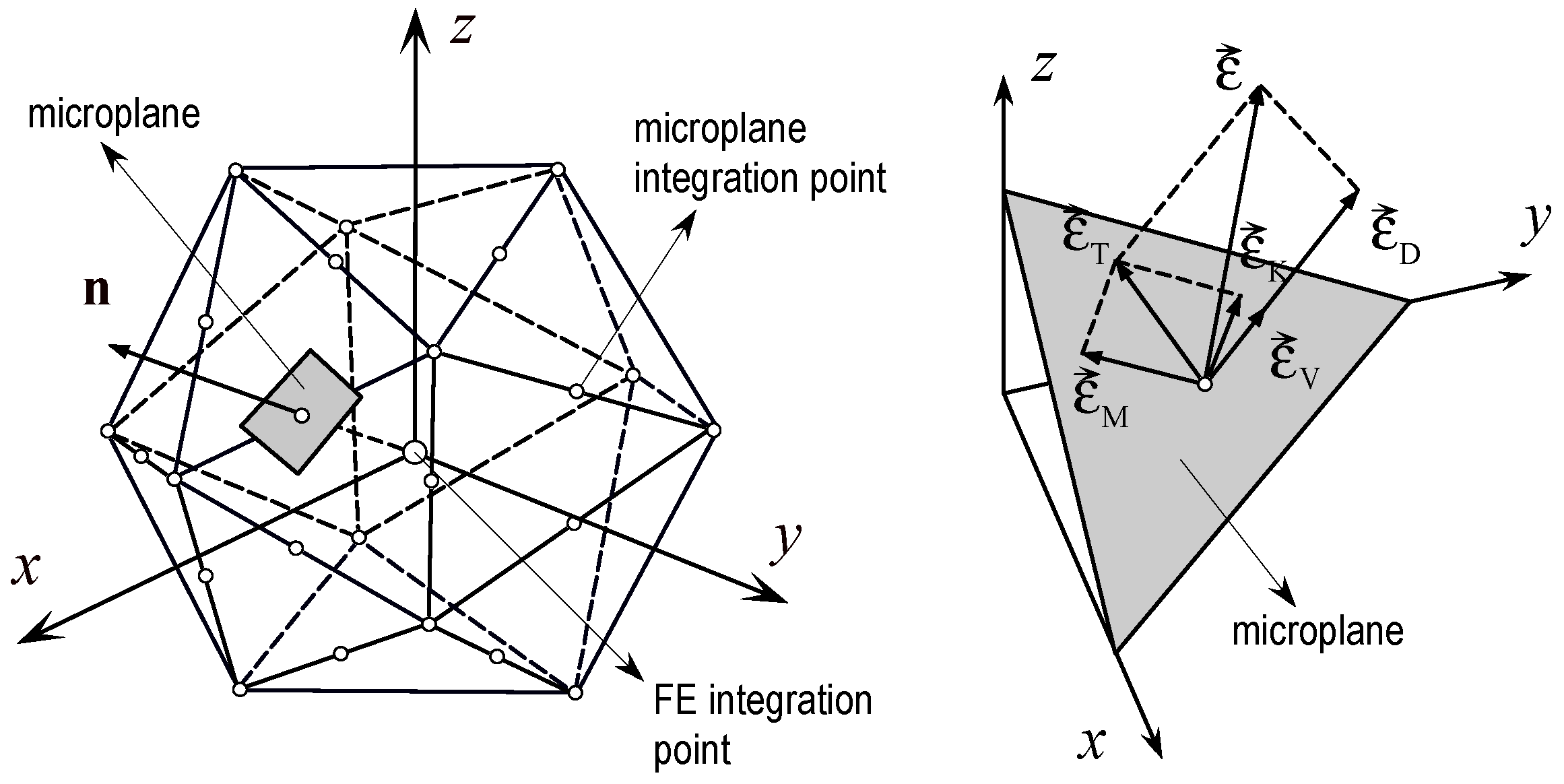

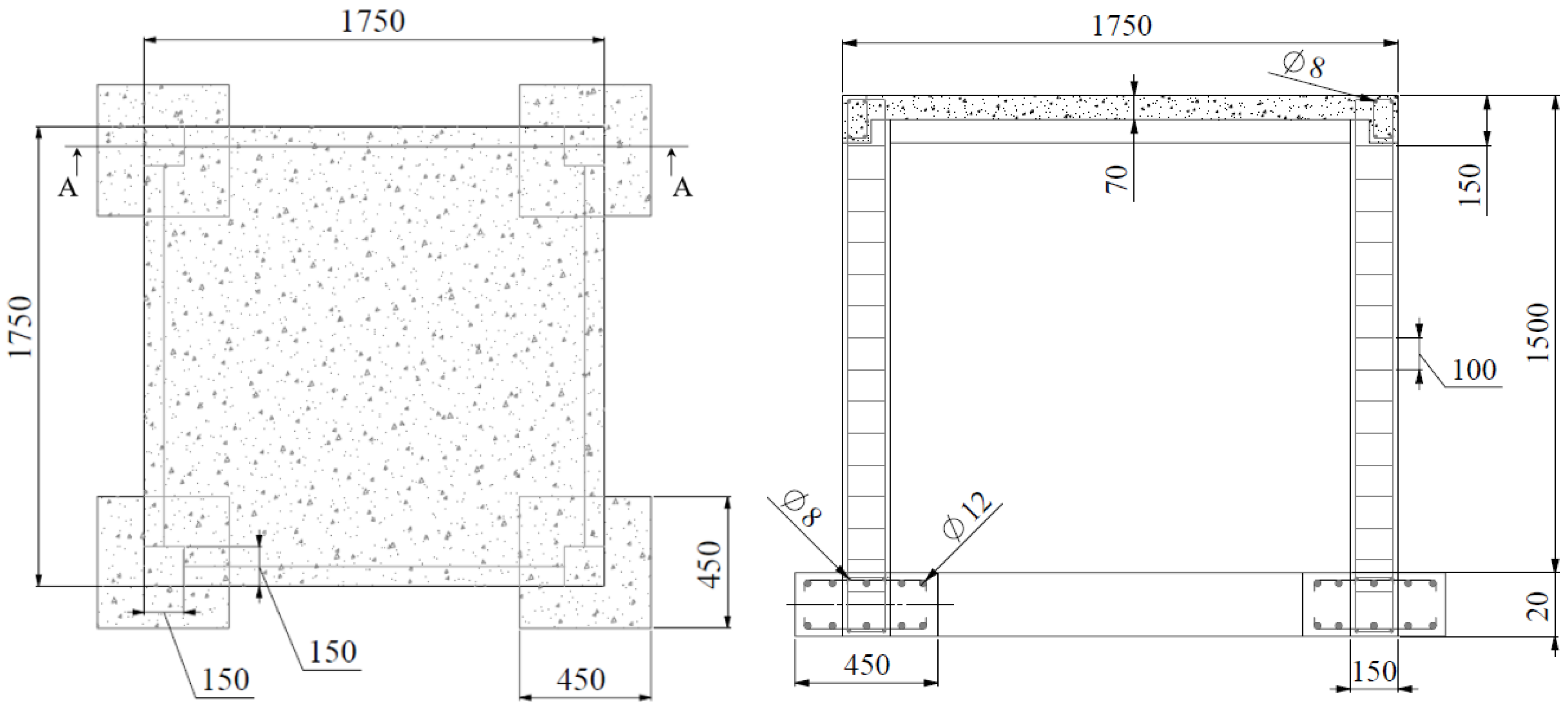
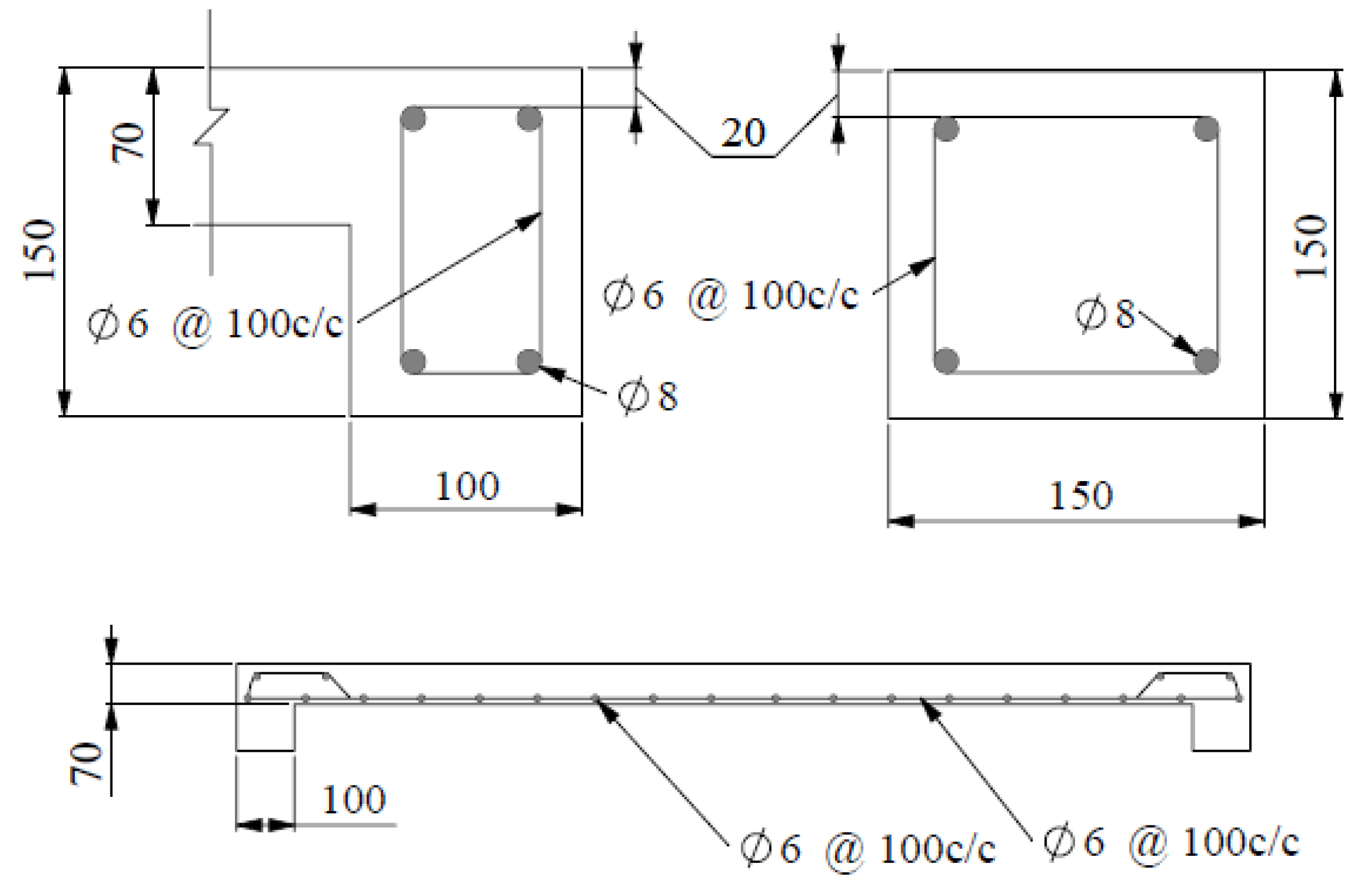
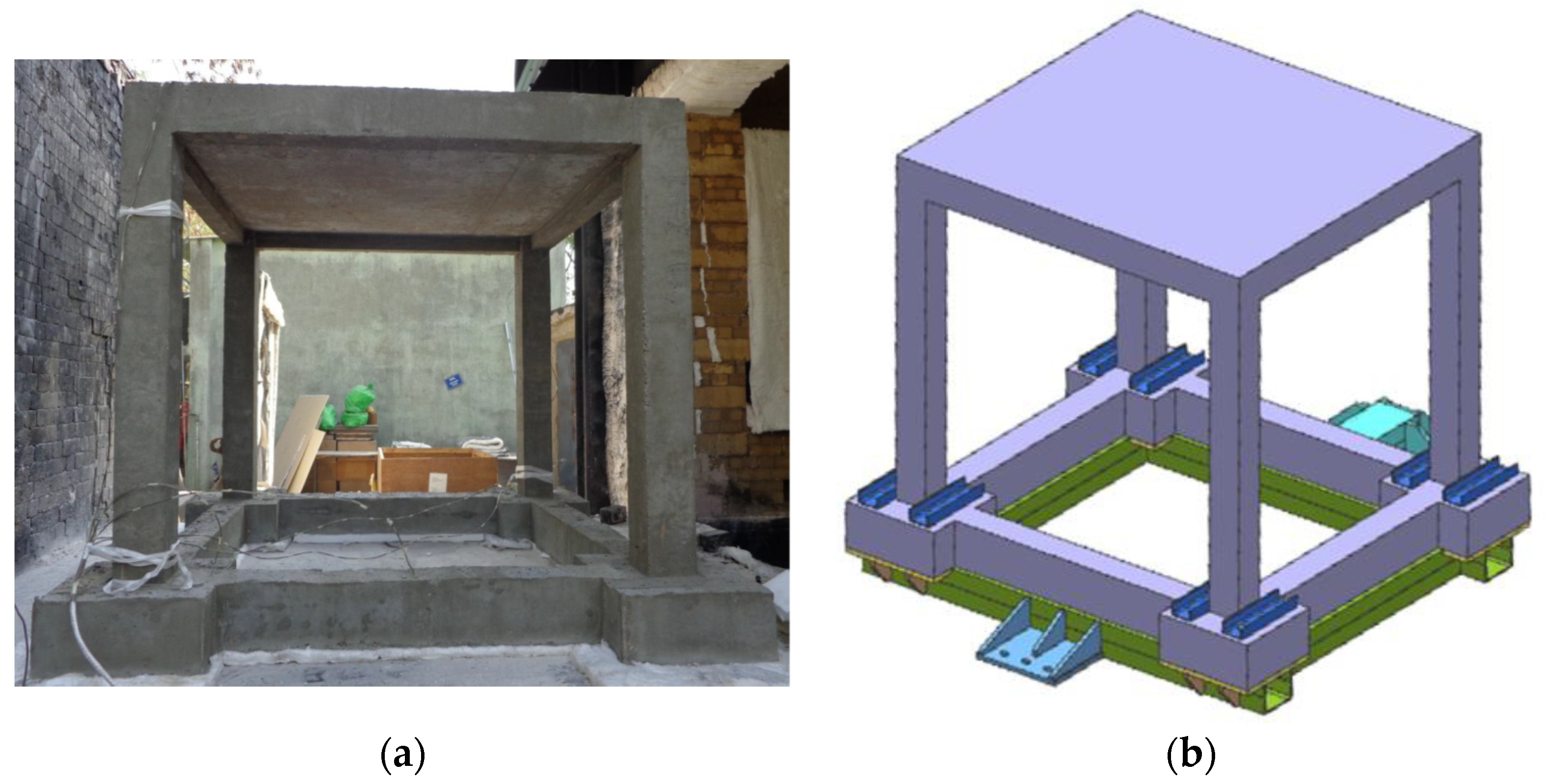
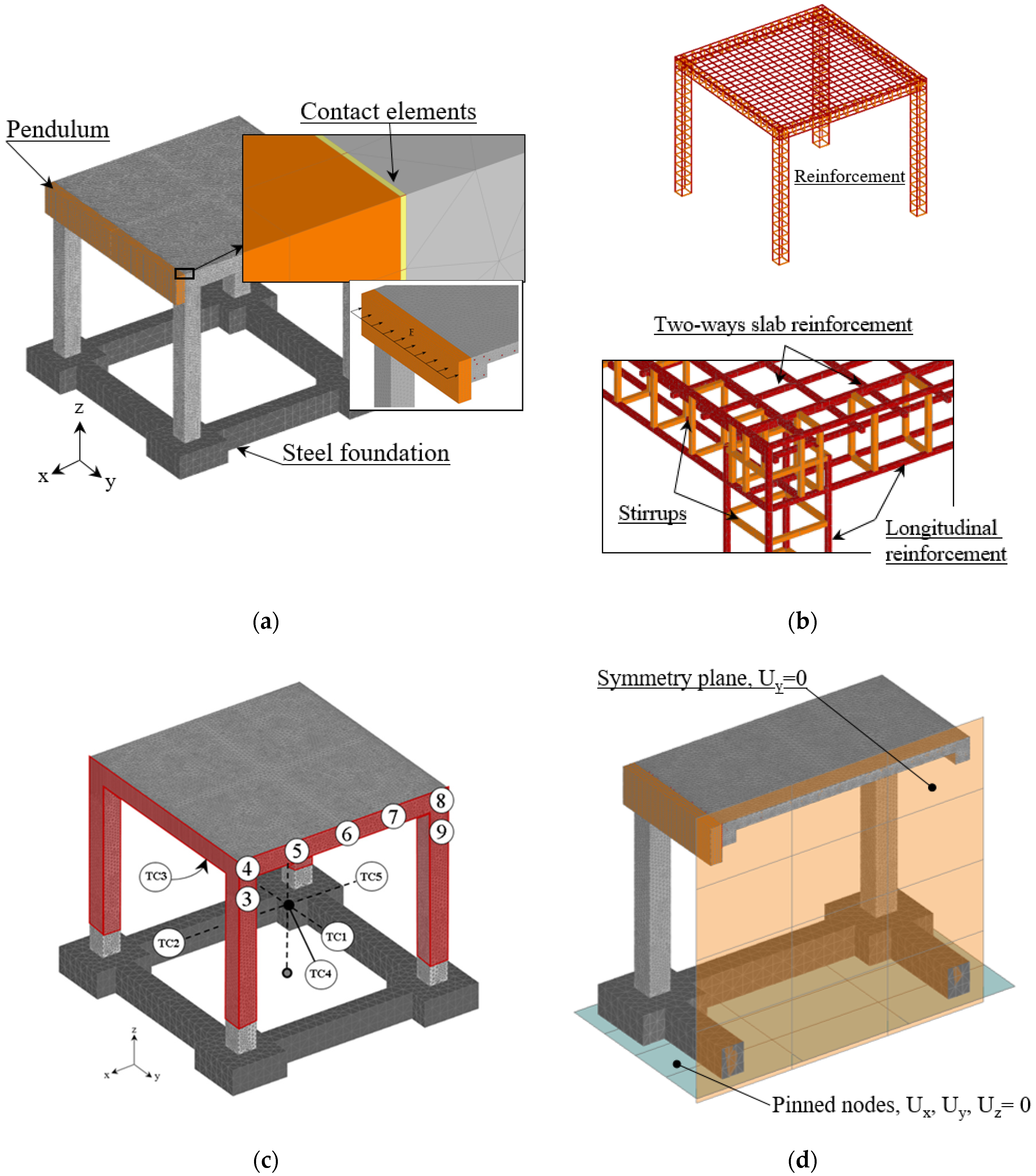

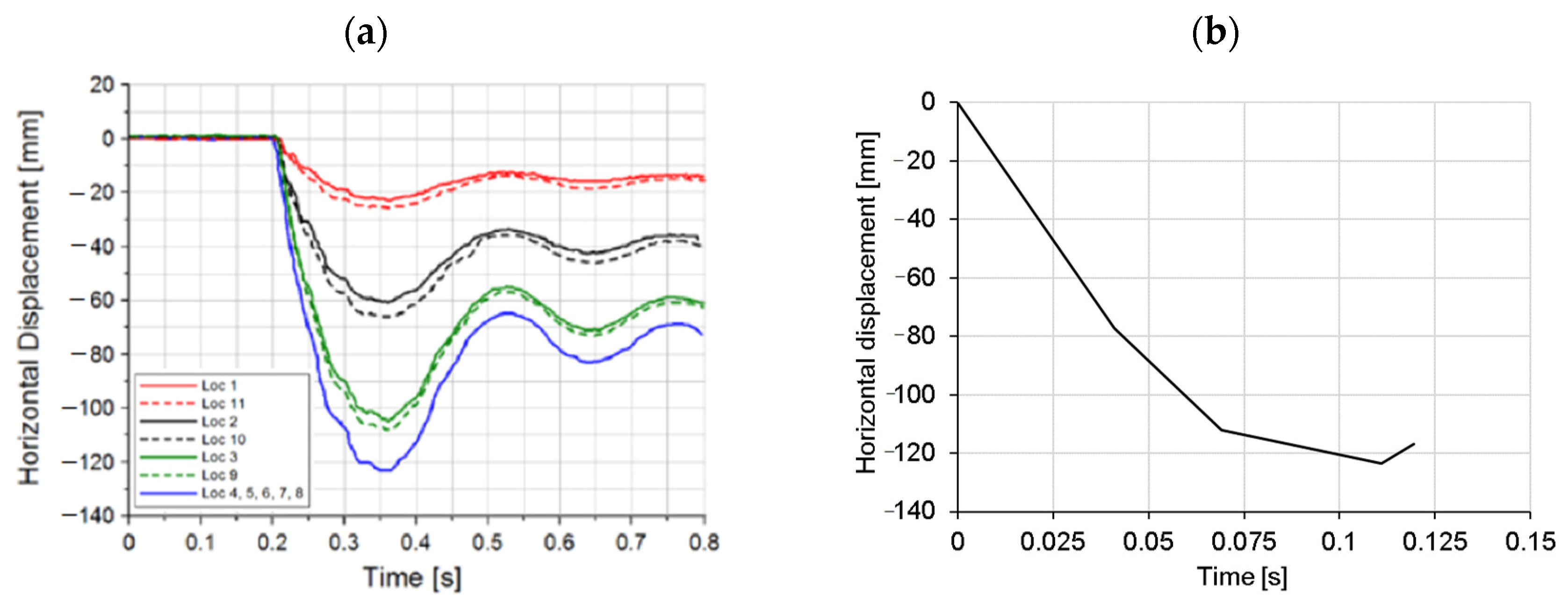
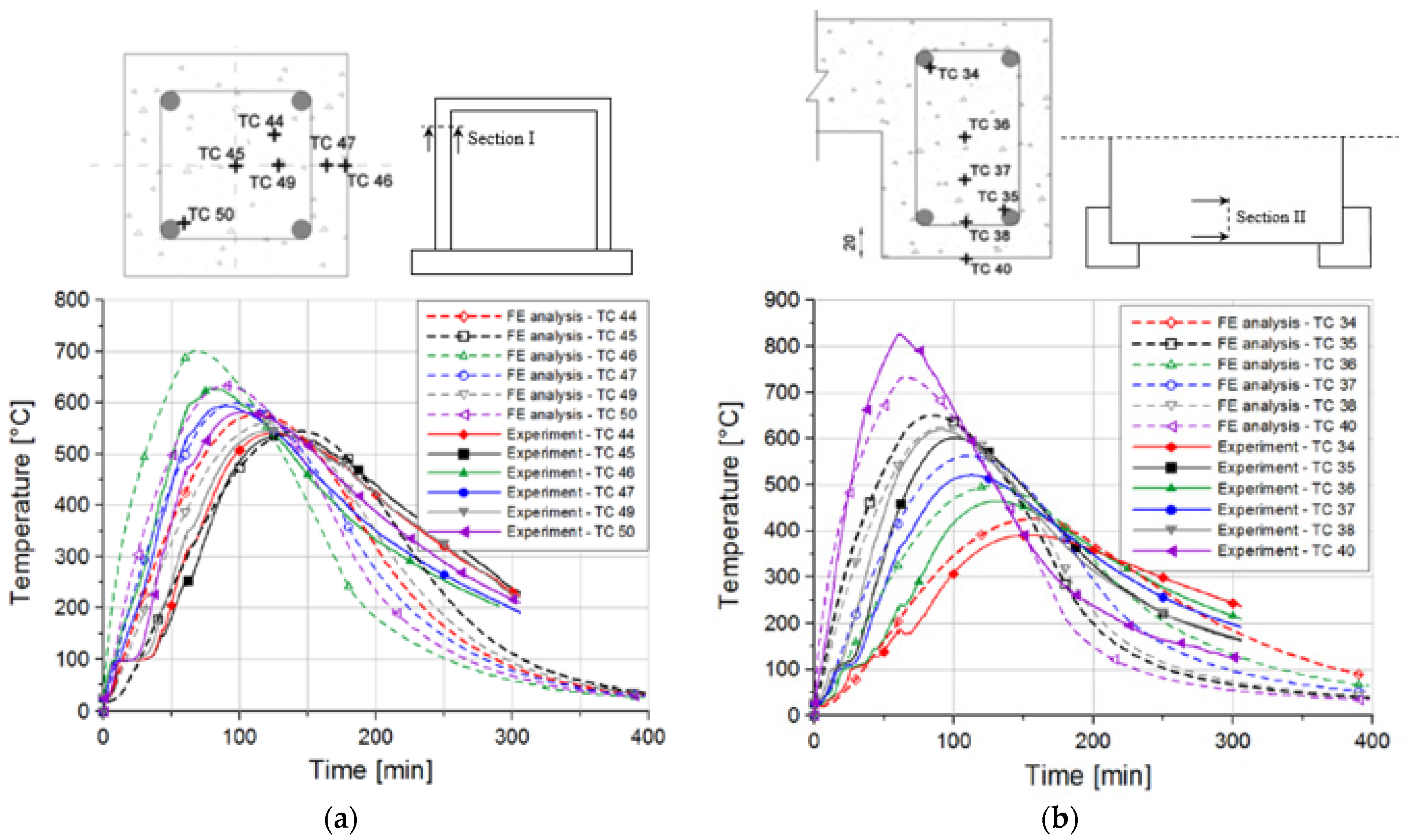

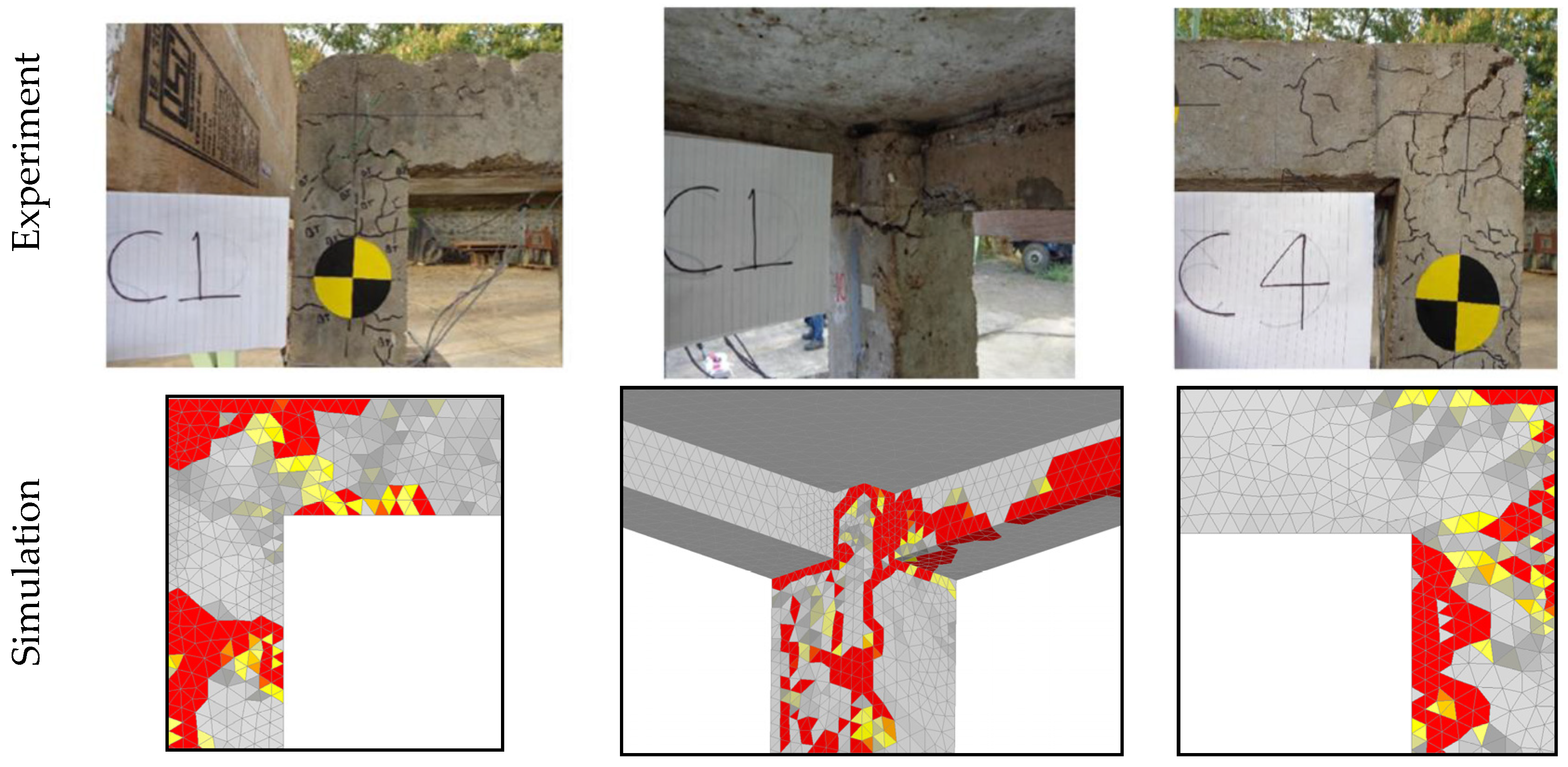
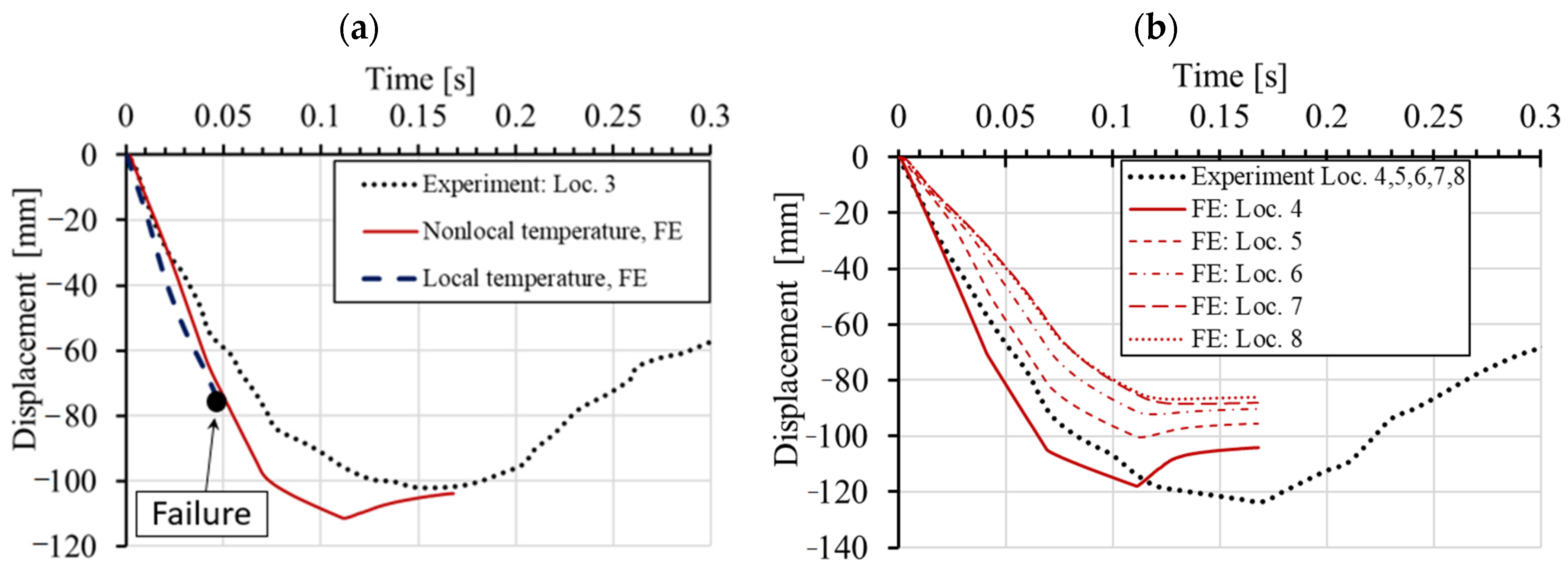
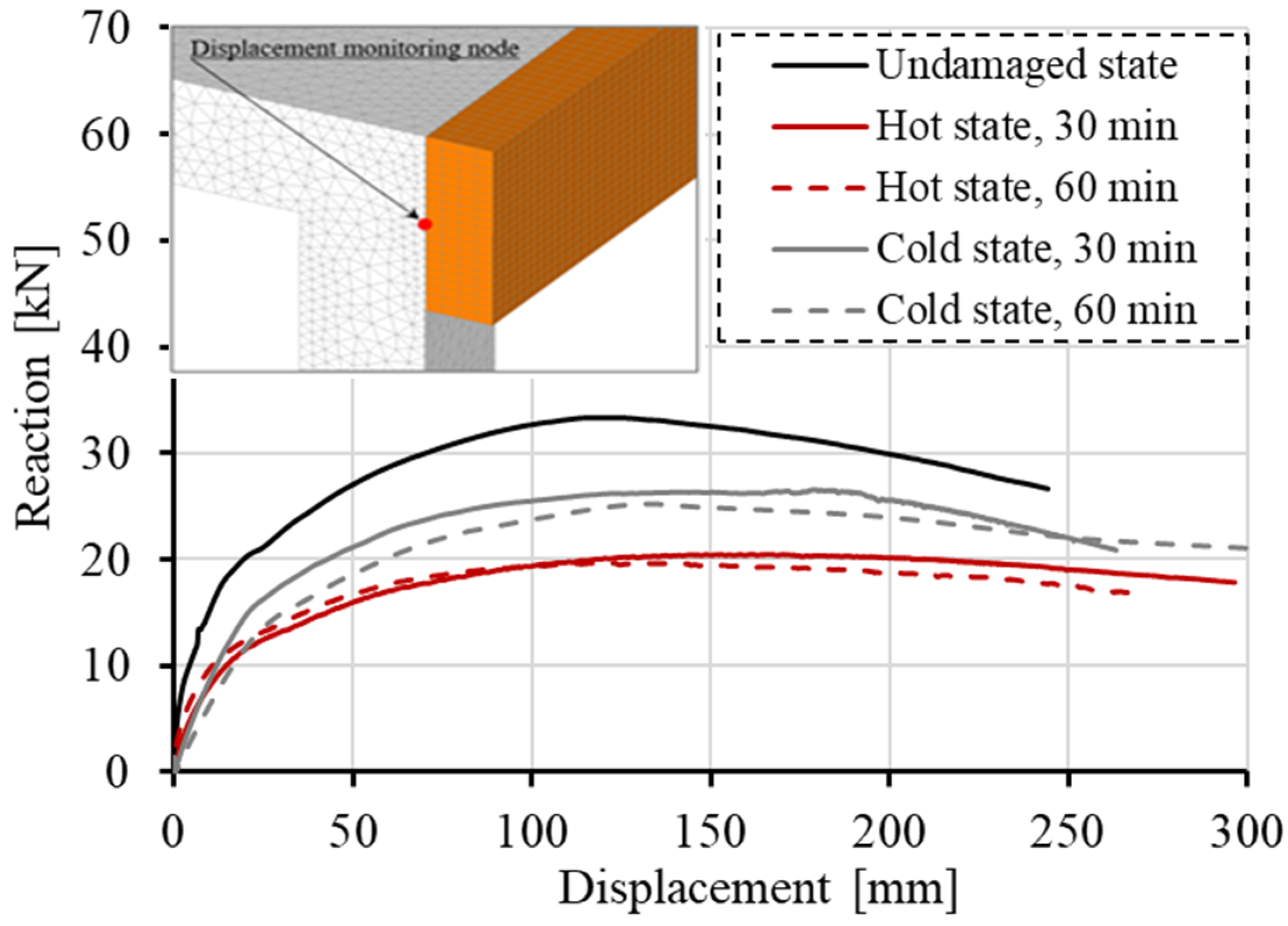

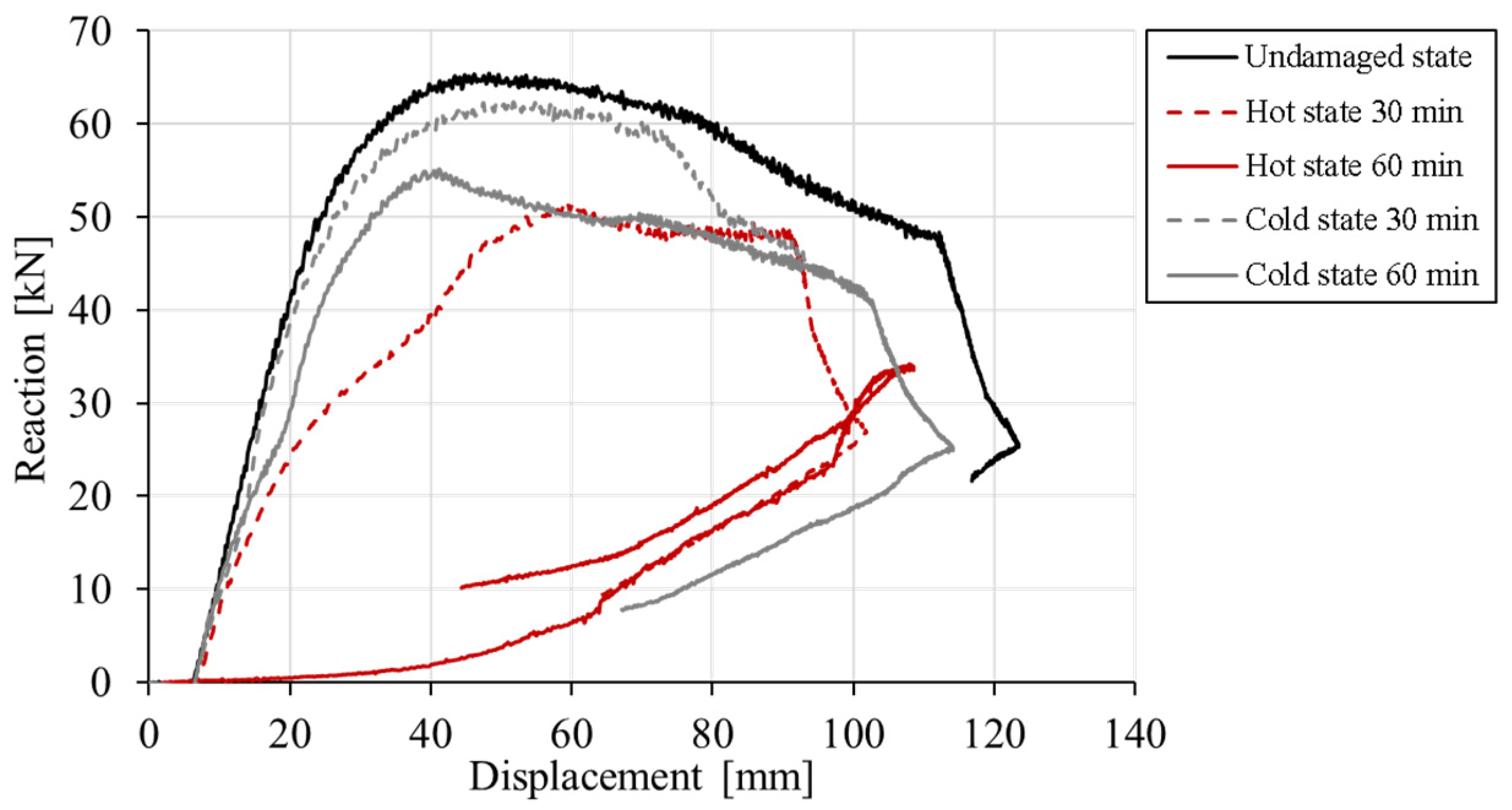
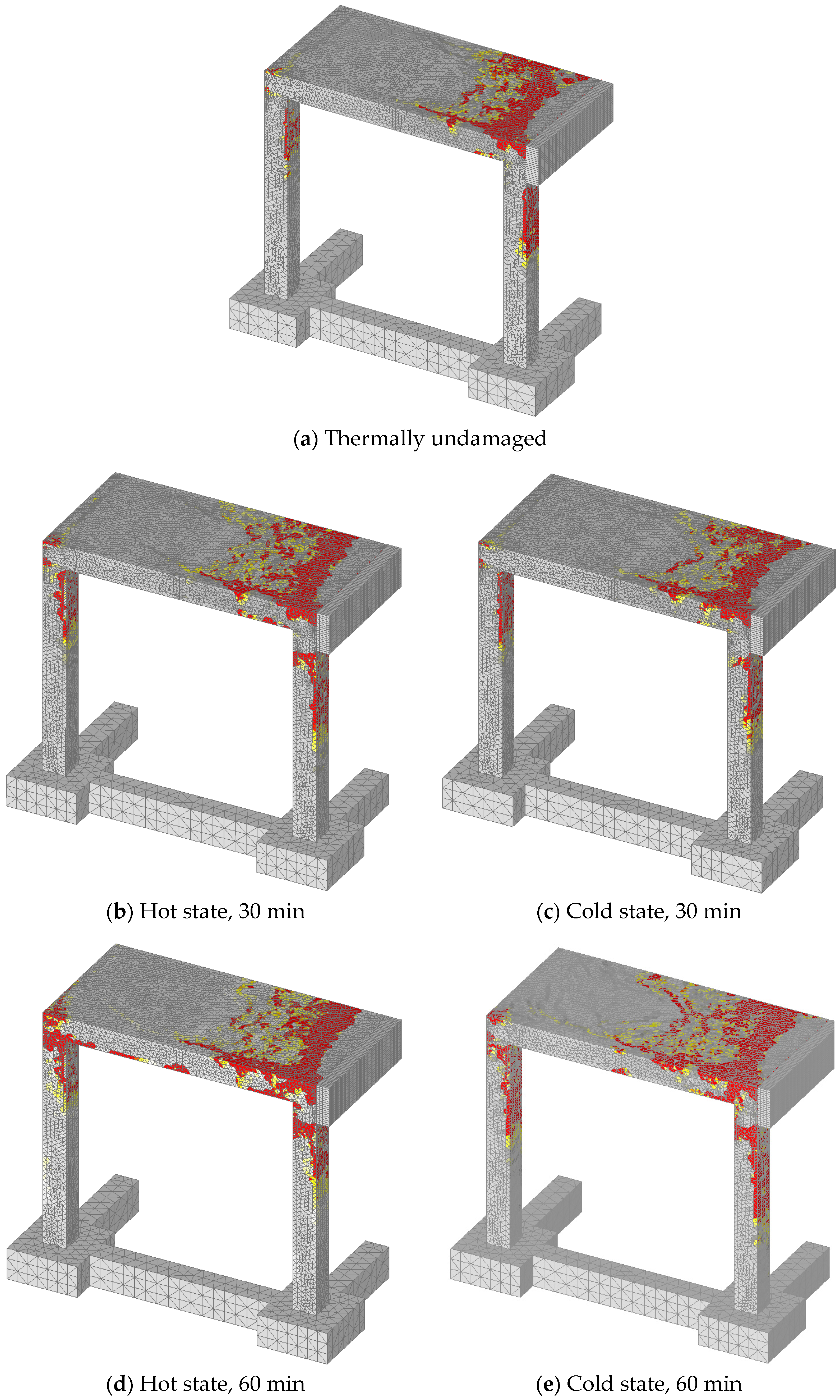
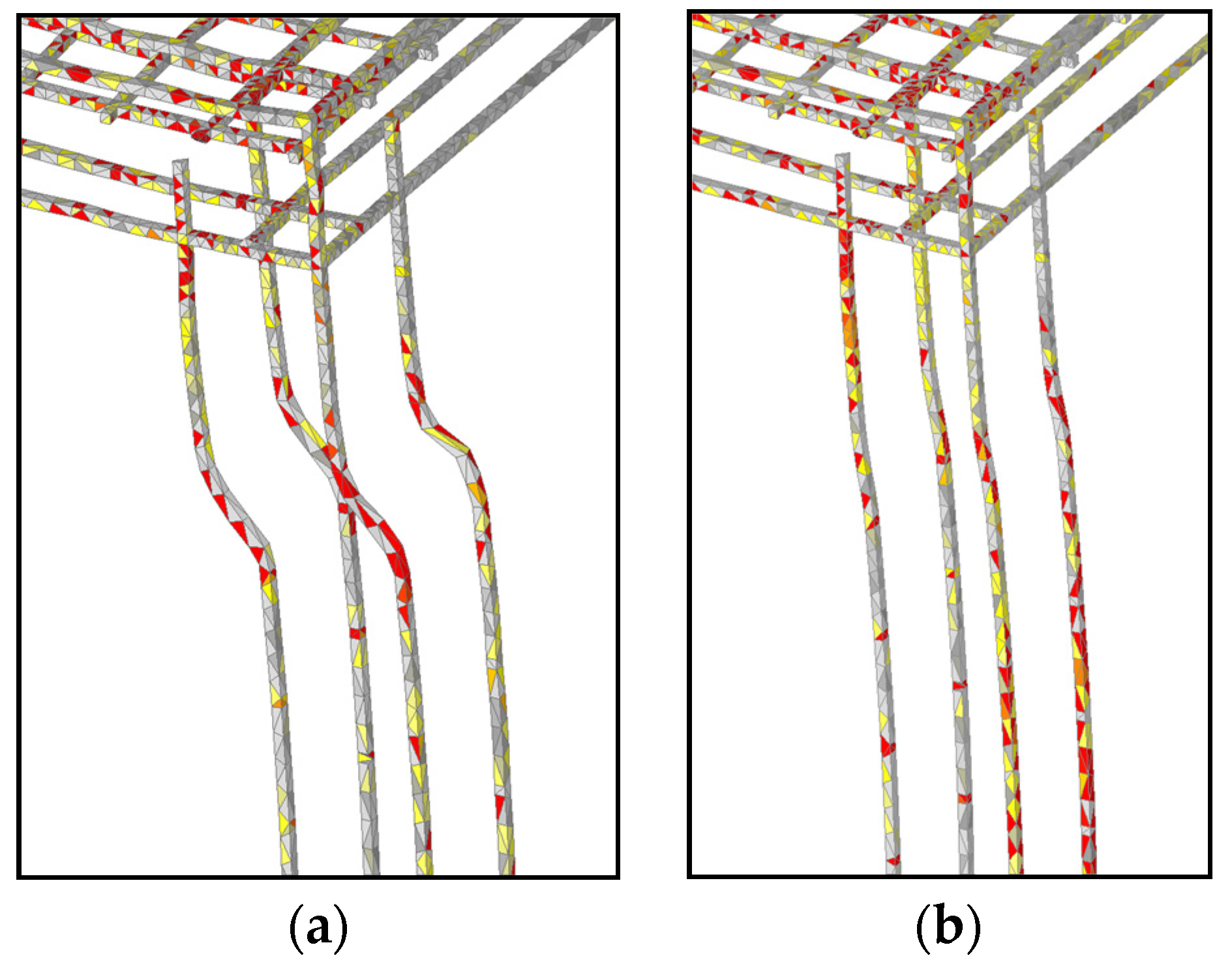
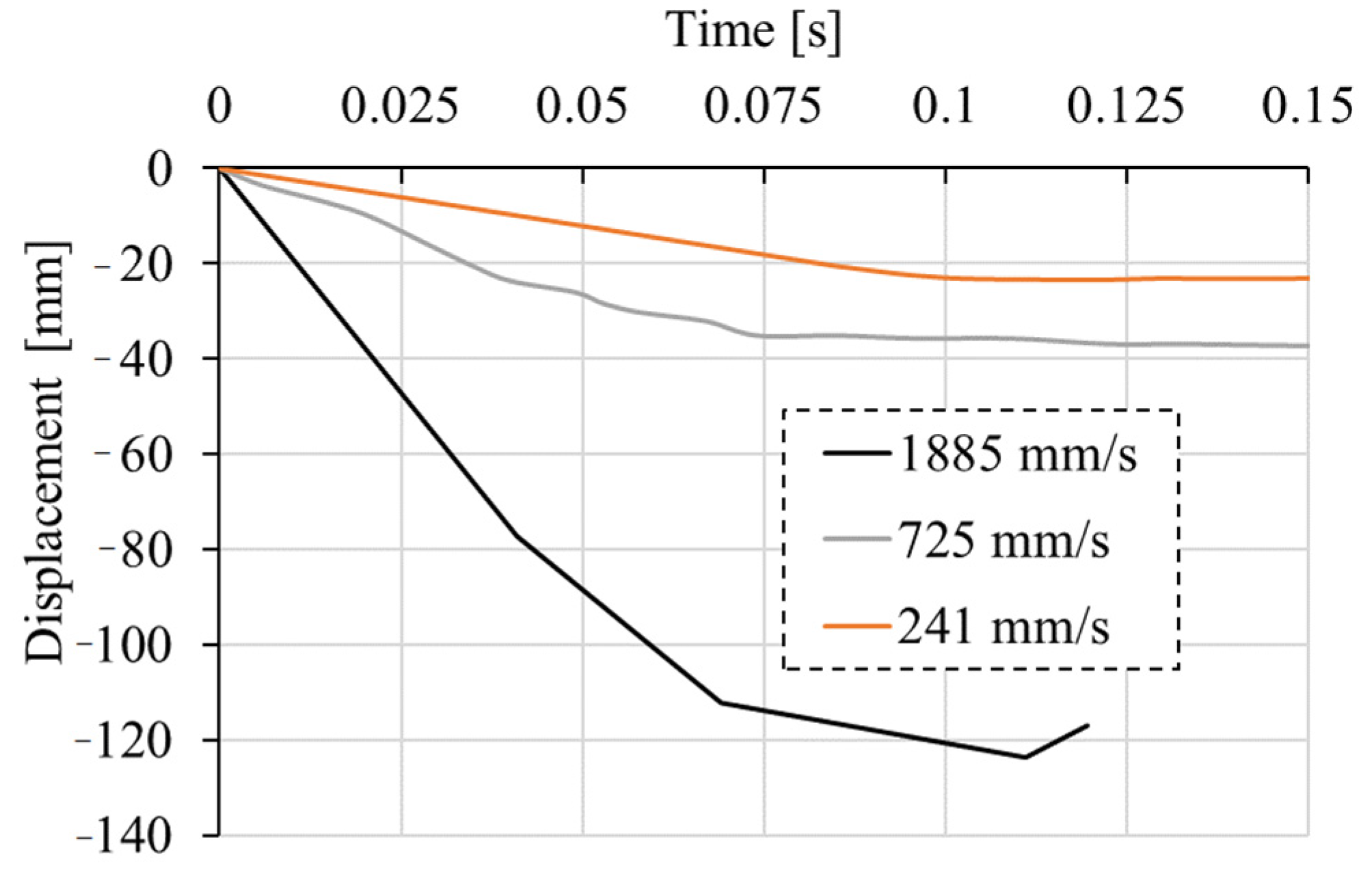



| Property | Concrete | Reinforcement Steel |
|---|---|---|
| Weight density (kg/m3) | 2400 | 7800 |
| Young’s modulus (MPa) | 26,300 | 210,000 |
| Compressive (cylinder) strength (MPa) | 18.20 | - |
| Tensile strength (MPa) | 1.40 | - |
| Fracture energy (J/m2) | 46.00 | - |
| Poisson’s ratio | 0.18 | 0.33 |
| Yield stress (MPa) | - | 480 |
| Strength (MPa) | - | 550 |
| Heat capacity (J/kgK) | 900 | 490 |
| Heat conductivity (W/mK) | 1.36 | 43.0 |
| State | Rstat (kN) | Rdyn (kN) | RDIF (Rdyn/Rstat) |
|---|---|---|---|
| Undamaged | 33.28 | 65.43 | 1.97 |
| Hot state (30 min) | 20.45 | 51.29 | 2.51 |
| Cold state (30 min) | 26.56 | 62.46 | 2.35 |
| Hot state (60 min) | 19.70 | 33.97 | 1.72 |
| Cold state (60 min) | 24.82 | 55.01 | 2.22 |
Publisher’s Note: MDPI stays neutral with regard to jurisdictional claims in published maps and institutional affiliations. |
© 2020 by the authors. Licensee MDPI, Basel, Switzerland. This article is an open access article distributed under the terms and conditions of the Creative Commons Attribution (CC BY) license (http://creativecommons.org/licenses/by/4.0/).
Share and Cite
Ožbolt, J.; Lacković, L.; Ruta, D. Impact Analysis of Thermally Pre-Damaged Reinforced Concrete Frames. Materials 2020, 13, 5349. https://doi.org/10.3390/ma13235349
Ožbolt J, Lacković L, Ruta D. Impact Analysis of Thermally Pre-Damaged Reinforced Concrete Frames. Materials. 2020; 13(23):5349. https://doi.org/10.3390/ma13235349
Chicago/Turabian StyleOžbolt, Joško, Luka Lacković, and Daniela Ruta. 2020. "Impact Analysis of Thermally Pre-Damaged Reinforced Concrete Frames" Materials 13, no. 23: 5349. https://doi.org/10.3390/ma13235349




